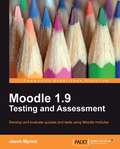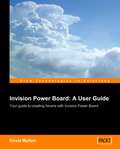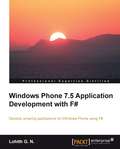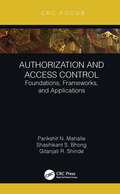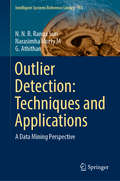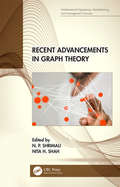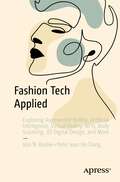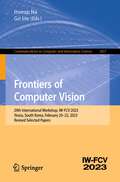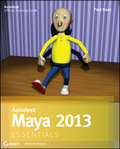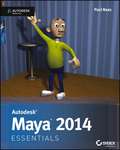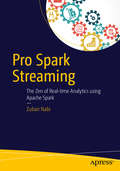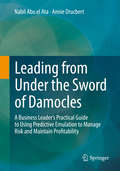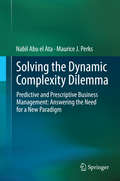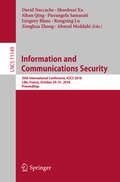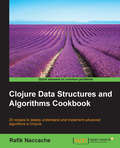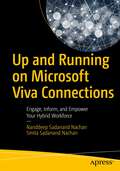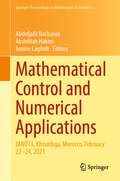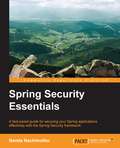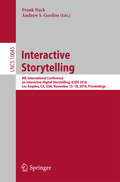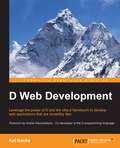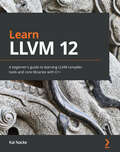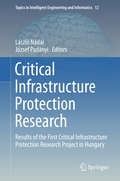- Table View
- List View
Moodle 1.9 Testing and Assessment
by Jason MyrickThis book is an illustrative how-to guide with many screenshots and examples that helps you to create simple to complex tests and assess them using Moodle. It covers effective usage of tools available in Moodle and offers some Moodle options that you may not have tried yet. It will guide you from the basic philosophy of online testing to creating skill-based assessments in Moodle.If you are a tutor or Moodle Administrator who is responsible for developing and evaluating an online test using Moodle, then this book is for you.This book assumes that you have already successfully installed and set up a Moodle site for teaching.
Invision Power Board 2: A User Guide
by David MyttonThis book is a fast-paced guide to the most important features of Invision Power Board, and how to make best use of these features to power your forum. This book is written for new and intermediate users of Invision Power Board, who want to manage and maintain an Invision Power Board discussion forum as easily as possible. No experience of web programming is required.
Windows Phone 7.5 Application Development with F#
by Lohith G. NA short book with important concepts and instructions.This book is for those who want to find out more about Windows Phone and are familiar with functional programming languages, and in particular, F#. The book assumes that you know how to program using F# as a language. However, the book does take you through a brief introduction to Windows Phone as a platform and F# as a language.As with all Packt books this guide will use practical examples to impart information to the reader.
Authorization and Access Control: Foundations, Frameworks, and Applications
by Parikshit N. Mahalle Shashikant S. Bhong Gitanjali R. ShindeThis book focuses on various authorization and access control techniques, threats and attack modeling, including an overview of the Open Authorization 2.0 (OAuth 2.0) framework along with user-managed access (UMA) and security analysis. Important key concepts are discussed regarding login credentials with restricted access to third parties with a primary account as a resource server. A detailed protocol overview and authorization process, along with security analysis of OAuth 2.0, are also discussed in the book. Case studies of websites with vulnerability issues are included. FEATURES Provides an overview of the security challenges of IoT and mitigation techniques with a focus on authorization and access control mechanisms Discusses a behavioral analysis of threats and attacks using UML base modeling Covers the use of the OAuth 2.0 Protocol and UMA for connecting web applications Includes role-based access control (RBAC), discretionary access control (DAC), mandatory access control (MAC) and permission-based access control (PBAC) Explores how to provide access to third-party web applications through a resource server by use of a secured and reliable OAuth 2.0 framework This book is for researchers and professionals who are engaged in IT security, auditing and computer engineering.
Outlier Detection: A Data Mining Perspective (Intelligent Systems Reference Library #155)
by N. N. Ranga Suri Narasimha Murty M G. AthithanThis book, drawing on recent literature, highlights several methodologies for the detection of outliers and explains how to apply them to solve several interesting real-life problems. The detection of objects that deviate from the norm in a data set is an essential task in data mining due to its significance in many contemporary applications. More specifically, the detection of fraud in e-commerce transactions and discovering anomalies in network data have become prominent tasks, given recent developments in the field of information and communication technologies and security. Accordingly, the book sheds light on specific state-of-the-art algorithmic approaches such as the community-based analysis of networks and characterization of temporal outliers present in dynamic networks. It offers a valuable resource for young researchers working in data mining, helping them understand the technical depth of the outlier detection problem and devise innovative solutions to address related challenges.
Recent Advancements in Graph Theory (Mathematical Engineering, Manufacturing, and Management Sciences)
by N. P. Shrimali and Nita H. ShahGraph Theory is a branch of discrete mathematics. It has many applications to many different areas of Science and Engineering. This book provides the most up-to-date research findings and applications in Graph Theory. This book focuses on the latest research in Graph Theory. It provides recent findings that are occurring in the field, offers insights on an international and transnational levels, identifies the gaps in the results, and includes forthcoming international studies and research, along with its applications in Networking, Computer Science, Chemistry, and Biological Sciences, etc. The book is written with researchers and post graduate students in mind.
Fashion Tech Applied: Exploring Augmented Reality, Artificial Intelligence, Virtual Reality, NFTs, Body Scanning, 3D Digital Design, and More
by Von N. Ruzive Peter Jeun Ho TsangProvide a more tactile experience for your customers, who won’t even need to physically visit stores while optimizing conventional production processes and eradicating the tenuous tasks that nobody really likes to do. Reevaluate all parts of the value chain. You’ll see the ways technology has been used by fashion brands so far within design, production, marketing, and retail. Then discover the market opportunity that technologies such as 3D printing, augmented reality, and more bring into the chain. Challenge the ways in which you implement basic functions in your own practices. Despite the dominance of brick & mortar stores, digital platforms have emerged to pave the way for more diverse retail experiences with the adoption of technology in the fashion industry.We’re talking about more than just online shopping. Tap into NFTs, online fitting rooms, and tech solutions for better customer acquisition and increased sales. Fashion tech is more than just clothing covered in LEDs. It is the adoption of value chain optimizations, customer experience enhancing tools, and advanced operations management into existing business models. When taken seriously by the industry, it will be the future of how we all sell and purchase our products and interact with them. With a particular focus on apparel, each section of this book will put a lens on the existing conventions practiced in the industry at all stages of the value chain and how the help of technology could completely transform fashion for a more cost efficient, sustainable and time efficient industry.Use augmented reality, virtual reality, NFTs, body scanning, 3D design, and more to completely revolutionize how you approach fashion. Both as a consumer and as an amazing designer! What You'll LearnBecome more creative in the way you hack any part of the fashion value chainSpark inspiration for implementations of new technologies in fashion for both customers and designersAdopt and stay forward-thinking by diving into where the industry currently is and where it is goingWho This Book Is ForDecision makers in fashion corporate companies and emerging fashion brands wondering how to innovate in the saturated fashion market, as well as, fashion students with an interest in building the future of fashion. No prior technology knowledge is needed.
Frontiers of Computer Vision: 29th International Workshop, IW-FCV 2023, Yeosu, South Korea, February 20–22, 2023, Revised Selected Papers (Communications in Computer and Information Science #1857)
by Inseop Na Go IrieThis book constitutes refereed proceedings of the 29th International Workshop on Frontiers of Computer Vision, IW-FCV 2023, held in Yeosu, South Korea in February 20–22, 2023. This workshop is an annual event that brings together researchers in the field of computer vision and artificial intelligence to share their research results. The workshop was started 29 years ago as a way to strengthen networking and share research results between Japanese and Korean researchers, and it has since grown in scope and influence, so from 2017, the workshop became an international event. The 13 full papers presented in this volume were thoroughly reviewed and selected from 72 submissions in 8 countries. The papers are dealing with the following topics:basic theories related to image processing, computer vision, image media, and human interface, as well as all research fields in applied fields such as autonomous vehicle driving, robot automation, and image content recognition. Recently, topics related to application of medical, bio, and entertainment field applying artificial intelligence , and more.
Autodesk Maya 2013 Essentials
by Paul NaasRecommnded text for those preparing for the Maya Associate exam Maya, the industry-leading 3D animation and effects software used in movies, games, cartoons, and commercials, is challenging to learn. This full-color guide features approachable, hands-on exercises and additional task-based tutorials that allow new users to quickly become productive with the program and familiar with its workflow in a professional environment. You'll learn the basics of modeling, texturing, animating, and lighting; explore different parts of the production pipeline; and practice on some real-world projects. Maya is the 3D animation and effects software used in the film, game, and advertising industries; it's a complex program and this book gives beginners essential training in Maya basics This book is an Autodesk Official Training Guide, recommended for students planning to take the Maya Associate exam Provides task-based tutorials and hands-on exercises to get you up to speed and introduce you to production workflows Teaches the basics of modeling, texturing, animating, and lighting Helps you create simple animations, model with polygons, and add detail with blend shapes and surfaces Starting and ending files for the exercises and additional learning tutorials are available online Autodesk Maya Essentials provides beginners with a solid foundation in Maya 3D software.
Autodesk Maya 2014 Essentials
by Paul NaasThe premiere book on getting started with Maya 2014Whether you're just beginning, or migrating from another 3D application, this step-by-step guide is what you need to get a good working knowledge of Autodesk Maya 2014. Beautifully illustrated with full-color examples and screenshots, Autodesk Maya 2014 Essentials explains the basics of Maya as well as modeling, texturing, animating, setting a scene, and creating visual effects. You'll absorb important concepts and techniques, and learn how to confidently use Maya tools the way professionals do.Each chapter includes fun and challenging hands-on projects, which you can do as you go using the downloadable files from the book's website. They include starting and ending files, so you can compare your results to how professionals do the projects. This information-packed Autodesk Official Press book also helps you prepare for the Autodesk Maya 2014 certification exams. Helps beginners and those migrating from other 3D animation and effects programs get up and running on Autodesk Maya 2014Features step-by-step tutorials, hands-on exercises with downloadable files, and four-color examples and screenshotsCovers modeling, texturing, animating, visual effects, lighting, compositing, setting a scene, and moreWritten by an Autodesk Authorized Author and is an Autodesk Official Press Autodesk Maya is the industry-leading 3D animation and effects software used in movies, games, cartoons, short films, commercials, and other animationGet firsthand experience with Maya 2014, as well as an initial start on preparing for the Autodesk Maya 2014 Certified Professional exam, with Autodesk Maya 2014 Essentials.
How to Cheat in Maya 2017: Tools and Techniques for Character Animation (How To Cheat)
by Paul NaasThis is not a book about Maya software with a few animation pointers thrown in here and there. This is a guide to Maya software written by professional animators. This book provides you with complete, set-by-step walkthroughs of essential animation techniques that increase your speed and efficiency while using Maya 2017 for character animation. From curves to constraints, this book covers all of the methods available in the latest version of Maya. Featuring gold-mine coverage this book teaches you new techniques for working with characters in animation tests and short films. Accompanied by a companion site, this is the one and only guide to get you up to speed. <P><P>Key Features <li>Complete step-by-step, walkthroughs of essential techniques every animator needs to know. <li>Features interviews with leading experts and experienced animation leads. <li>Companion web site including all exercise/example scene files and extras such as video tutorials and animation files. <li>Interlude articles covering everything from Reference Video to Resumes.
Pro Spark Streaming
by Zubair NabiLearn the right cutting-edge skills and knowledge to leverage Spark Streaming to implement a wide array of real-time, streaming applications. This book walks you through end-to-end real-time application development using real-world applications, data, and code. Taking an application-first approach, each chapter introduces use cases from a specific industry and uses publicly available datasets from that domain to unravel the intricacies of production-grade design and implementation. The domains covered in the book include social media, the sharing economy, finance, online advertising, telecommunication, and IoT. In the last few years, Spark has become synonymous with big data processing. DStreams enhance the underlying Spark processing engine to support streaming analysis with a novel micro-batch processing model. Pro Spark Streaming by Zubair Nabi will enable you to become a specialist of latency sensitive applications by leveraging the key features of DStreams, micro-batch processing, and functional programming. To this end, the book includes ready-to-deploy examples and actual code. Pro Spark Streaming will act as the bible of Spark Streaming. What you'll learn Spark Streaming application development and best practices Low-level details of discretized streams The application and vitality of streaming analytics to a number of industries and domains Optimization of production-grade deployments of Spark Streaming via configuration recipes and instrumentation using Graphite, collectd, and Nagios Ingestion of data from disparate sources including MQTT, Flume, Kafka, Twitter, and a custom HTTP receiver Integration and coupling with HBase, Cassandra, and Redis Design patterns for side-effects and maintaining state across the Spark Streaming micro-batch model Real-time and scalable ETL using data frames, SparkSQL, Hive, and SparkR Streaming machine learning, predictive analytics, and recommendations Meshing batch processing with stream processing via the Lambda architecture Who this book is for The audience includes data scientists, big data experts, BI analysts, and data architects.
Leading from Under the Sword of Damocles: A Business Leader's Practical Guide To Using Predictive Emulation To Manage Risk And Maintain Profitability
by Nabil Abu el Ata Annie DrucbertGlobalization trends and the rapid pace of technological innovations have introduced unprecedented change and uncertainty. For unprepared businesses, the drivers of the Fourth Industrial Revolution will become a constant source of surprise and crises will unfold at an ever-increasing rate. To thrive under these conditions, companies must adopt new risk management technologies and practices that enable business leaders to better anticipate and adjust to changing dynamics.This book helps readers understand how algorithm-based predictive and prescriptive analytics principles can be used to control risk in today’s dynamic business environment. It serves as a reference guide for business leaders and risk management practitioners of companies that are global in reach or operate dynamically complex systems. Using the technological and scientific innovations presented in this book, business leaders can gain a wider understanding of risk and prescriptively determine which actions are necessary to ensure the business is optimally positioned to meet its stated long-term goals and objectives.Case studies show how the presented methods can be practically applied to preemptively expose risks and support decisions to optimize, transform or disrupt current business models, strategies, organizational structure and information systems when necessary to maintain a market position or outperform competitors.These methods have been proven through hundreds of client cases. By using mathematical emulation to link business risks to strategic imperatives, it becomes possible to achieve a higher annual profit margin and better growth. As we enter the Fourth Industrial Revolution, companies that are able to expose risks caused by dynamic complexity and maintain the alignment between the goals of the business and operational execution will be better prepared to make the shifts necessary for long-term success and keep the business moving toward its goals.
Solving the Dynamic Complexity Dilemma
by Nabil Abu el Ata Maurice J. PerksDynamic complexity results from hidden, unknown factors--or more precisely, interactions between factors--that can unexpectedly impact the performance of systems. When the influences of dynamic complexity are not measured and understood, new never-seen-before behaviors can come as unwelcomed surprises, which disrupt the performance of systems. Left alone, processes that were once prized for their efficiency unexpectedly begin to degrade--costs increase, while volumes and quality decline. Evidence of problems may come too late for effective resolution as technology advancements induce rapid change and compress the time available to react to that change. The results of dynamic complexity are always negative and unmanaged dynamic complexity can bring business or global systems to the point of sudden chaos. The 2009 H1N1 pandemic, 2008 Credit Crunch and 2011 Fukushima Daiichi nuclear disaster are global examples of the dangers of undiagnosed dynamic complexity. With increasing frequency executive leaders today are discovering that their business and IT system performance levels are not meeting expectations. In most cases these performance deficiencies are caused by dynamic complexity, which lies hidden like a cancer until the symptoms reveal themselves--often when it is too late to avoid negative impacts on business outcomes. This book examines the growing business problem of dynamic complexity and presents a path to a practical solution. To achieve better predictability, organizations must be able to expose new, dangerous patterns of behavior in time to take corrective actions and know which actions will yield the optimal results. The book authors promote new methods of risk management that use data collection, analytics, machine learning and automation processes to help organizations more accurately predict the future and take strategic actions to improve performance outcomes. The presented means of achieving this goal are based upon the authors' practical experiences, backed by scientific principles, and results achieved through consulting engagements with over 350 global organizations.
Information and Communications Security: 20th International Conference, ICICS 2018, Lille, France, October 29-31, 2018, Proceedings (Lecture Notes in Computer Science #11149)
by David Naccache Shouhuai Xu Sihan Qing Pierangela Samarati Gregory Blanc Rongxing Lu Zonghua Zhang Ahmed MeddahiThis book constitutes the refereed proceedings of the 20th International Conference on Information and Communications Security, ICICS 2018, held in Lille, France, in October 2018. The 39 revised full papers and 11 short papers presented were carefully selected from 202 submissions. The papers are organized in topics on blockchain technology, malware, botnet and network security, real-world cryptography, encrypted computing, privacy protection, signature schemes, attack analysis and detection, searchable encryption and identity-based cryptography, verifiable storage and computing, applied cryptography, supporting techniques, formal analysis and cryptanalysis, attack detection, and security management.
Clojure Data Structures and Algorithms Cookbook
by Rafik Naccache25 recipes to deeply understand and implement advanced algorithms in Clojure About This Book * Explore various advanced algorithms and learn how they are used to address many real-world computing challenges * Construct elegant solutions using impressive techniques including zippers, parsing, and pattern matching * Solve complex problems by adopting innovative approaches such as logic or asynchronous programming In Detail Data-structures and algorithms often cross your path when you compress files, compile programs, access databases, or simply use your favourite text editor. Understanding and implementing them can be daunting. Curious learners and industrial developers can find these complex, especially if they focus on the detailed implementation of these data structures. Clojure is a highly pragmatic and expressive language with efficient and easy data manipulation capabilities. As such, it is great for implementing these algorithms. By abstracting away a great share of the unnecessary complexity resulting from implementation, Clojure and its contrib libraries will help you address various algorithmic challenges, making your data exploration both profitable and enjoyable. Through 25 recipes, you'll explore advanced algorithms and data-structures, well served by a sound Clojure implementation. This book opens with an exploration of alternative uses of the array data-structure, covering LZ77 compression, drawing fractals using Pascal's triangles, simulating a multi-threaded program execution, and implementing a call-stack winding and un-winding operations. The book elaborates on linked lists, showing you how to construct doubly linked ones, speed up search times over the elements of such structures, use a linked-list as the foundation of a shift-reduce parser, and implement an immutable linked-list using skew binary numbers representation. After that, the tree data-structure is explored, focusing on building self-balancing Splay Trees, designing a B-Tree backing-up an efficient key-value data-store, constructing an undo capable Rope, and showing how Tries can make for an auto-completing facility. Next, some optimization and machine learning techniques are discussed, namely for building a co-occurrence-based recommendation engine, using branch-and-bound to optimize integral cost and profit problems, using Dijkstra's algorithm to determine optimal paths and summarizing texts using the LexRank algorithm. Particular attention is given to logic programming, you will learn to use this to discover interesting relations between social website data, by designing a simple type inferencer for a mini Java-like language, and by building a simple checkers game engine. Asynchronous programming will be addressed and you will design a concurrent web-crawler, an interactive HTML5 game, and an online taxi booking platform. Finally, you'll explore advanced cases for higher order functions in Clojure while implementing a recursive descent parser using efficient mutual resucrsion, devising a mini resusable firewall simulator thanks to Clojure 1.7 new tansducers feature or building a simple unification engine with the help of Continuation Passing Style. What You Will Learn * Explore alternative uses of classical data-structures like arrays and linked-lists * Discover advanced types of tree data-structures * Explore advanced machine learning and optimization techniques * Utilise powerful Clojure libraries, such as Instaparse for parsing, core.match for pattern matching, clojure.zip for zippers, and clojure.matrix for matrix operations * Learn logic programming through the usage of the library core.logic * Master asynchronous programming using the core.async library * See the transducers in action while resolving real-world use-cases Who This Book Is For If you are an experienced Clojure developer, longing to take your knowledge to the next level by discovering and using advanced algorithms and seeing how they can be applied to real-world problems, then this book is for you.
Up and Running on Microsoft Viva Connections: Engage, Inform, and Empower Your Hybrid Workforce
by Nanddeep Sadanand Nachan Smita Sadanand NachanLeverage the collaboration capabilities of Microsoft Viva Connections as an employee experience platform to build a gateway to your digital workplace. This book helps you set up Microsoft Viva connections via easy-to-follow steps and extend it to target your business scenarios.The book starts with an introduction to Microsoft Viva and its modules and it discusses Viva Connections for desktop and mobile users. You will learn about the intranet landing experience with SharePoint where you will plan, build, and launch a home site. You will know how to use the app bar and global navigation in Viva Connections and understand the importance of the dashboard and dashboard cards. You will learn how to enable Viva Connections in MS Teams and define a rollout strategy. You will gain experience with Viva Connections on mobile devices and go through end-user guidance. And you will learn to extend Viva Connections with the SharePoint Framework and deploy SPFx solutions. After reading this book, you will be able to set up Microsoft Viva Connections for your digital workplace and empower your employees to search and discover relevant news, information, content, and sites from across the organization.What Will You LearnUnderstand the modern experience in SharePoint with Microsoft Viva ConnectKnow best practices for your home site in SharePointGet your content ready for feed with SharePoint and YammerBuild Adaptive Card Extensions (ACEs) with SPFxDefine governance for Viva ConnectionsWho This Book Is ForMicrosoft professionals and business users who want to leverage the collaboration capabilities of Microsoft Viva Connections
Mathematical Control and Numerical Applications: JANO13, Khouribga, Morocco, February 22–24, 2021 (Springer Proceedings in Mathematics & Statistics #372)
by Abdeljalil Nachaoui Abdelilah Hakim Amine LaghribThis book presents some sufficient mathematical content with expressive result. The aim of JANO13 is to bring together scientists to discuss their research in all the aspects of mathematics and their applications to different scientific discipline. The main topics of the conference is partial differential equations, mathematical control, numerical analysis and computer science. The conference is interested in recent developments on numerical analysis and real applications in computer science. The latter is viewed as a dynamic branch on the interface of mathematics and informatics that has been growing rapidly over the past several decades. However, its mathematical modelling and interpretation are still not well-explained and need much more clarifications. The main contributions of this book are to give some sufficient mathematical content with expressive results. As a growing field, it is gaining a lot of attention both in media and in the industry world, which will attract the interest of readers from different scientist disciplines.
Spring Security Essentials
by Nanda NachimuthuA fast-paced guide for securing your Spring applications effectively with the Spring Security frameworkAbout This BookExplore various security concepts using real-time examples of the Spring Security frameworkLearn about the functionalities that implement industry standard authentication and authorization mechanisms to secure enterprise-level applicationsDesign and develop advanced Spring Security layers by following a step-by-step approachWho This Book Is ForIf you are a developer who is familiar with Spring and you are looking to explore its security features, then this book is for you. All beginners and experienced users will benefit from this book since it is explores both the theory and practical usage in detail.What You Will LearnSee industry standard security implementations in actionUnderstand the principles of security servers, concepts, installation, and integrationUse Spring Extensions for various security mechanismsGet to grips with the internals of the tools and servers involved in the security layerWork through practical projects and working programsCompare different security servers and techniquesUse the sample projects in practical, real-time applicationsGet further readings and guidance on advanced security mechanismsIn DetailSpring Security is a framework that focuses on providing both authentication and authorization to Java applications. Like all Spring projects, the real power of Spring Security is how easily it can be extended to meet custom requirements. The popularity of the Spring framework is increasing and the security package of Spring addresses vast mechanisms of Security in a rich way. Due to an increasing number of applications for various business needs, the integration of multiple applications is becoming inevitable. The standard security procedures available across multiple implementations in Spring will protect vulnerable applications that are open to larger public and private audiences.Spring Security Essentials focuses on the need to master the security layer, which is an area not often explored by a Spring developer.At the beginning, we'll introduce various industry standard security mechanisms and the practical ways to integrate with them. We will also teach you about some up-to-date use cases such as building a security layer for RESTful web services and applications.The IDEs used and security servers involved are briefly explained, including the steps to install them. Many sample projects are also provided to help you practice your newly developed skills. Step-by-step instructions will help you master the security layer integration with the Server, then implement the experience gained from this book in your own real-time application.Style and approachThis practical guide is packed with detailed explanations of the underlying concepts, as well as screenshots and working examples that guarantee hands-on learning.
Interactive Storytelling
by Frank Nack Andrew S. GordonThis book constitutes the refereed proceedings of the 9th International Conference on Interactive Digital Storytelling, ICIDS 2016, held in Los Angeles, CA, USA, in November 2016. The 26 revised full papers and 8 short papers presented together with 9 posters, 4 workshop, and 3 demonstration papers were carefully reviewed and selected from 88 submissions. The papers are organized in topical sections on analyses and evaluation systems; brave new ideas; intelligent narrative technologies; theoretical foundations; and usage scenarios and applications.
Interactive Storytelling: 9th International Conference on Interactive Digital Storytelling, ICIDS 2016, Los Angeles, CA, USA, November 15–18, 2016, Proceedings (Lecture Notes in Computer Science #10045)
by Frank Nack Andrew S. GordonThis book constitutes the refereed proceedings of the 9th International Conference on Interactive Digital Storytelling, ICIDS 2016, held in Los Angeles, CA, USA, in November 2016. The 26 revised full papers and 8 short papers presented together with 9 posters, 4 workshop, and 3 demonstration papers were carefully reviewed and selected from 88 submissions. The papers are organized in topical sections on analyses and evaluation systems; brave new ideas; intelligent narrative technologies; theoretical foundations; and usage scenarios and applications.
D Web Development
by Kai NackeLeverage the power of D and the vibe.d framework to develop web applications that are incredibly fast About This Book * Utilize the elegant vibe.d framework to build web applications easily and REST backends with the D programming language * Learn about all components of vibe.d to enhance your web development with D * A hands-on guide to the vibe.d framework; from static web pages to template-based, interactive and localized web applications with database access and REST backends Who This Book Is For Whether you are new to the world of D, or already have developed applications in D, or if you want to leverage the power of D for web development, then this book is ideal for you. Basic knowledge of core web technologies like HTML 5 is helpful but not required. This book explains the difficult details to speed your web development. What You Will Learn * Create amazingly fast web applications with D * Use Diet templates to easily create a web user interface * Utilize the web framework for interactive applications with input validation and internationalization * Access a database to provide persistent storage for your application * Extend your application with a REST interface and access other applications via REST * Understand vibe.d's fiber-based approach to asynchronous I/O and use it for integration of existing components * Create GUI applications with vibe.d In Detail D is a programming language with C-like syntax and static typing. The vibe.d framework builds on powerful D concepts like template meta-programming and compile-time function execution to provide an easy-to-use environment for web applications. The combination of a feature-rich web programming framework with a language compiling to native code solves two common issues in web development today: it accelerates your development and it results in fast, native web applications. Learning the vibe.d framework before you start your application will help you to choose the right features to reach your goal. This book guides you through all aspects of web development with D and the vibe.d framework. Covering the popular operating systems today, this guide starts with the setup of your development system. From the first Hello World-style application you will move on to building static web pages with templates. The concise treatment of web forms will give you all the details about form handling and web security. Using the abstractions of the web framework you will learn how to easily validate user input. Next, you will add database access to your application, providing persistent storage for your data. Building on this foundation, you will expose your component and integrate other components via REST. Learning about the internals of vibe.d you will be able to use low-level techniques such as raw TCP access. The vibe.d concepts can also be used for GUI clients, which is the next topic that you will learn. vibe.d is supported by an active community, which adds new functionality. This comprehensive guide concludes with an overview of the most useful vibe.d extensions and where to find them. It also shows you how to integrate these extensions in your application. The concepts are always illustrated with source code, giving you an insight into how to apply them in your application. Style and approach A tutorial-style guide to develop web applications with D and the vibe.d framework. Each topic is explained in detail and illustrated with source code, providing you with hands-on assistance for your application.
Learn LLVM 12: A beginner's guide to learning LLVM compiler tools and core libraries with C++
by Kai NackeLearn how to build and use all parts of real-world compilers, including the frontend, optimization pipeline, and a new backend by leveraging the power of LLVM core librariesKey FeaturesGet to grips with effectively using LLVM libraries step-by-step Understand LLVM compiler high-level design and apply the same principles to your own compiler Use compiler-based tools to improve the quality of code in C++ projectsBook DescriptionLLVM was built to bridge the gap between compiler textbooks and actual compiler development. It provides a modular codebase and advanced tools which help developers to build compilers easily. This book provides a practical introduction to LLVM, gradually helping you navigate through complex scenarios with ease when it comes to building and working with compilers. You'll start by configuring, building, and installing LLVM libraries, tools, and external projects. Next, the book will introduce you to LLVM design and how it works in practice during each LLVM compiler stage: frontend, optimizer, and backend. Using a subset of a real programming language as an example, you will then learn how to develop a frontend and generate LLVM IR, hand it over to the optimization pipeline, and generate machine code from it. Later chapters will show you how to extend LLVM with a new pass and how instruction selection in LLVM works. You'll also focus on Just-in-Time compilation issues and the current state of JIT-compilation support that LLVM provides, before finally going on to understand how to develop a new backend for LLVM. By the end of this LLVM book, you will have gained real-world experience in working with the LLVM compiler development framework with the help of hands-on examples and source code snippets.What you will learnConfigure, compile, and install the LLVM frameworkUnderstand how the LLVM source is organizedDiscover what you need to do to use LLVM in your own projectsExplore how a compiler is structured, and implement a tiny compilerGenerate LLVM IR for common source language constructsSet up an optimization pipeline and tailor it for your own needsExtend LLVM with transformation passes and clang toolingAdd new machine instructions and a complete backendWho this book is forThis book is for compiler developers, enthusiasts, and engineers who are new to LLVM and are interested in learning about the LLVM framework. It is also useful for C++ software engineers looking to use compiler-based tools for code analysis and improvement, as well as casual users of LLVM libraries who want to gain more knowledge of LLVM essentials. Intermediate-level experience with C++ programming is mandatory to understand the concepts covered in this book more effectively.
Hate Speech and Political Violence: Far-Right Rhetoric from the Tea Party to the Insurrection
by Brigitte L. Nacos Robert Shapiro Yaeli Bloch-ElkonHow did the United States descend into crisis, with institutions frayed, political violence mounting, and democracy itself in peril? This timely book identifies how the Tea Party and its extremist narratives laid the groundwork for the rise of Donald Trump, his MAGA movement, and the January 6, 2021, assault on the Capitol.Brigitte L. Nacos, Yaeli Bloch-Elkon, and Robert Y. Shapiro trace the escalation of a strain of extremist rhetoric in right-wing political discourse after the inauguration of Barack Obama. Drawing on extensive and in-depth analysis of political communication in both traditional media and online spaces, they demonstrate how the dominant rhetorical styles of the Trump era were pioneered by the Tea Party. A backlash to the election of the first Black president, this reactionary social movement deployed violent language and spread anti-Obama paranoia, with the assistance of media insiders, GOP leaders, and conservative advocacy groups. Donald Trump rose to political prominence by hitching himself to the “birther” racist conspiracy theory, espoused by many Tea Partiers, and drew from their aggressive and hyperpartisan repertoire. Ultimately, this book shows, the increasingly violent rhetoric of right-wing extremists spilled over into real-world political violence. Revealing the path the Tea Party blazed to Trump and the insurrectionists, Hate Speech and Political Violence provides timely new insights into the threats facing American democracy.
Critical Infrastructure Protection Research: Results of the First Critical Infrastructure Protection Research Project in Hungary (Topics in Intelligent Engineering and Informatics #12)
by László Nádai József PadányiThis bookpresents recent research in the recognition of vulnerabilities of nationalsystems and assets which gained special attention for the CriticalInfrastructures in the last two decades. The book concentrates on R&Dactivities in the relation of Critical Infrastructures focusing on enhancingthe performance of services as well as the level of security. The objectives ofthe book are based on a project entitled "Critical InfrastructureProtection Researches" (TÁMOP-4. 2. 1. B-11/2/KMR-2011-0001) whichconcentrated on innovative UAV solutions, robotics, cybersecurity, surfaceengineering, and mechatornics and technologies providing safe operations ofessential assets. This report is summarizing the methodologies and effortstaken to fulfill the goals defined. The project has been performed by theconsortium of the Óbuda University and the National University of PublicService.
